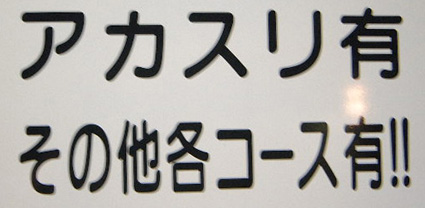Aka-suri
Aka-suri is a native Japanese word, from aka 'dirt, grime' and suru 'to rub'. It refers to a
vigorous rubbing down with a towel after a bath or sauna to cleanse the skin
and pores of accumulated dirt.
But for the orthographic purge after WWII, aka-suri would be written    .
Unfortunately, although an easy enough character to remember, .
Unfortunately, although an easy enough character to remember,  aka has been omitted from the list of
officially approved characters, which means that it must be written in newspapers,
textbooks, etc. as aka has been omitted from the list of
officially approved characters, which means that it must be written in newspapers,
textbooks, etc. as  . .
Since  is an approved character for suru 'to rub', is an approved character for suru 'to rub',    aka-suri should be the default form. But there
are two factors working against aka-suri should be the default form. But there
are two factors working against    : :
1)    violates a primary tendency in Japanese writing, namely, the 'head word' in
a compound like this should have the heavier weight and should be in kanji;
the verb-form that follows is lighter in weight and can be either written
in characters or reduced to hiragana. Putting the 'head word' aka in hiragana and the verb suri in kanji makes this spelling 'bottom-heavy'. violates a primary tendency in Japanese writing, namely, the 'head word' in
a compound like this should have the heavier weight and should be in kanji;
the verb-form that follows is lighter in weight and can be either written
in characters or reduced to hiragana. Putting the 'head word' aka in hiragana and the verb suri in kanji makes this spelling 'bottom-heavy'.
2) Suru 'to rub' is one of those Japanese verbs
that could traditionally be written in several ways. In the meaning of 'to
rub' it could also be written   .
In the somewhat related meaning of 'to print' (including wood-block printing),
it is written .
In the somewhat related meaning of 'to print' (including wood-block printing),
it is written   ,
previously also ,
previously also   .
Since .
Since  is regarded as a moderately difficult character, many people are more comfortable
writing it in hiragana. is regarded as a moderately difficult character, many people are more comfortable
writing it in hiragana.
So what is the version in the street? One would assume the all-hiragana form   ,
but this is what I found outside an establishment that offered aka-suri as one of its services: ,
but this is what I found outside an establishment that offered aka-suri as one of its services:
 Aka-suri ari
Aka-suri ari
Sono ta kaku kōsu ari!!
Skin cleansing available
Various other courses available!! |
Why would a red-blooded Japanese compound like aka-suri be written in katakana, usually said to be the mark of foreign origins,
scientific usage, or onomatopoeia?
It could be because hiragana looks too lightweight, given that hiragana are mostly used for grammatical particles or verb endings. In an effort to stress
that aka-suri is a fully-fledged word with its
own identity, katakana has been used instead. It may also have been
influenced by the word kōsu in the second line,
which is written in katakana.
A Google search in August 2003 revealed the following distribution on the Internet:
There are several interesting, even surprising, points about this list.
1. Katakana   and hiragana and hiragana   are about equal in terms of occurrence. This suggests widespread dissatisfaction
with writing aka-suri in hiragana. are about equal in terms of occurrence. This suggests widespread dissatisfaction
with writing aka-suri in hiragana.
2.  aka is not yet dead. Despite being outlawed from the official characters, it is
still alive and well at third place with a respectable 4,350 occurrences for aka is not yet dead. Despite being outlawed from the official characters, it is
still alive and well at third place with a respectable 4,350 occurrences for   . .
3.   suri is not well at all. There is considerable
aversion to writing suri with the character suri is not well at all. There is considerable
aversion to writing suri with the character  ,
particularly in combination with hiragana ,
particularly in combination with hiragana  .
(Interestingly, Google turned up 3 hapless cases where aka-suri was written .
(Interestingly, Google turned up 3 hapless cases where aka-suri was written    ). ).
This is a rather telling example of the havoc wrought in some areas of the
Japanese vocabulary by the well-meaning policy of restricting the number of
characters. |
